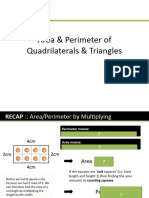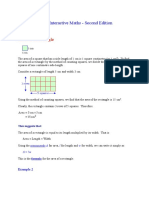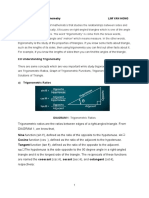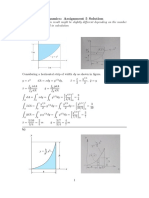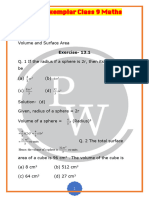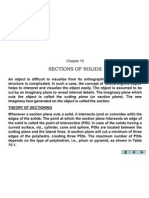Area of Reactangle and Parallelogram
Area of Reactangle and Parallelogram
Uploaded by
lolileeCopyright:
Available Formats
Area of Reactangle and Parallelogram
Area of Reactangle and Parallelogram
Uploaded by
lolileeOriginal Title
Copyright
Available Formats
Share this document
Did you find this document useful?
Is this content inappropriate?
Copyright:
Available Formats
Area of Reactangle and Parallelogram
Area of Reactangle and Parallelogram
Uploaded by
lolileeCopyright:
Available Formats
etc.
) The area of a rectangle is the number of unit
Area of Rectangle squares that can fit into a rectangle. Some
examples of rectangular shapes are the flat
The area of any shape is the number of unit
surfaces of laptop monitors, blackboards, painting
squares that can fit into it. Here "unit" refers to one
canvas, etc. You can use the formula of the area of
(1) and a unit square is a square with a side of 1
a rectangle to find the space occupied by these
unit. So, the area of a rectangle is the number of
objects. For example, let us consider a rectangle of
unit squares within the boundary of the rectangle.
length 4 inches and width 3 inches.
Alternatively, the space occupied within
the perimeter of a rectangle is called the area of the Area of a rectangle Definition: Area occupied by
rectangle. One good example of a rectangle shape a rectangle within its boundary is called the area of
is the square tiles of unit length in your house. You the rectangle.
can easily figure out how much space the floor
occupies by counting the number of tiles. This will
also help you determine the area of the rectangular
floor.
What Is Area of a Rectangle?
The area can be defined as the amount of space
covered by a flat surface of a particular shape. It is Let us draw unit squares inside the rectangle.
measured in terms of the "number of" square units Each unit square is a square of length 1 inch.
(square centimeters, square inches, square feet,
The formula of the area of a rectangle is used to
find the area occupied by the rectangle within its
boundary. In the above example, the area of the
rectangle whose length is 4 inches and the width is
3 inches is 12 square inches. We have 4 × 3 = 12.
The area of a rectangle is obtained by multiplying
its length and width. Thus, the formula for the area,
'A' of a rectangle whose length and width are 'l'
and 'w' respectively is the product "l × w".
Area of a Rectangle= (Length × Breadth)
square units
How to Calculate Area of Rectangle?
Now, count the number of unit squares in the
The area of a rectangle is equal to its length times
above figure. How many squares can you observe?
its width. Follow the steps mentioned below to find
There are 12 squares in total. We have already
the area of a rectangle.
learned that area is measured in square units.
• Step 1: Note the dimensions of length and
Since the unit of this rectangle is "inches," the area
breadth from the given data.
is measured and written in square inches. Thus,
• Step 2: Find the product of length and breadth
the Area of the above rectangle = 12 square
values.
inches.
• Step 3: Give the answer in square units.
Area of a Rectangle Formula
Let us take an example to understand the Now, the formula to calculate the area of a
calculation of the area of a rectangle. We will find rectangle is Length × Breadth. Alternatively, we
the area of the rectangle whose length is 15 units can write this product as (⎷ (Diagonal)2 -
and breadth is 4 units. To find the area, first, find (Breadth)2)× Breadth
the length and width. So, Area of a Rectangle = Breadth (⎷ (Diagonal)2 -
Given, length = 15 units and width = 4 units (Breadth)2)
The formula to find the area of a rectangle is A = l
× w. Substitute 15 for 'l' and 4 for 'w' in this
Why Area of a Rectangle Is Length ×
formula. Area of a rectangle = 15 × 4 = 60.
Breadth?
Therefore, the area of rectangle = 60 square units Have you ever wondered why the formula to find
Area of a Rectangle by Diagonal the area of a rectangle is Length × Breadth? Let's
derive the formula of the area of a rectangle. We
The diagonal of a rectangle is the straight line in will draw a diagonal AC in the rectangle ABCD.
the rectangle connecting its opposite vertices. Clearly, the diagonal AC divides the rectangle
There are two diagonals in the rectangle and both ABCD into two congruent triangles. The area of the
are of equal length. We can find the diagonal of a rectangle is the sum of the area of these two
rectangle by using the Pythagoras Theorem. triangles.
(Diagonal)2 = (Length)2 + (Breadth)2
(Length)2 = (Diagonal)2 - (Breadth)2
Length = ⎷ (Diagonal)2 - (Breadth)2
= 4800 square yards
Therefore, the Area of the farm is 4800 square
yards.
• Example 2:
Area of Rectangle ABCD = Area of Triangle ABC +
Peter reads his favorite comic book in his study
Area of Triangle ADC
room. Can you find the area of the book whose
= 2 × Area of Triangle ABC length is 314314 in. and width is 112112 in?
= 2 × (1/2 × Base × Height)
= AB × BC
= Length × Breadth
• Example 1: The length and width of a
rectangular farm are 80 yards and 60 yards. Find
Solution
the area of the farm.
Length of the book, l = 3 1/4 inches
Solution:
Width of the book, b = 1 1/2 inches
Length of the farm, l = 80 yd and width of the
Area of the rectangle A
farm, w = 60 yards
A=l×b
Area of the farm A is: A = l × w
= 3 1/4 × 1 1/2
= 80 yd × 60 yards = 13/4 × 3/2
= 39/8 parallelogram is a four-sided, 2-dimensional figure
= 4 7/8 in2 with:
So, The area of book is 4 7/8 square inches. • two equal, opposite sides,
• two intersecting and non-equal diagonals, and
Area of Parallelogram • opposite angles that are equal
We come across many geometric shapes other than
The area of a parallelogram is defined as the
rectangles and squares in our daily lives. Since
region or space covered by a parallelogram in a
few properties of a rectangle and the parallelogram
two-dimensional plane. A parallelogram is a
are somewhat similar, the area of the rectangle is
special kind of quadrilateral. If a quadrilateral has
similar to the area of a parallelogram.
two pairs of parallel opposite sides, then it is called
Area of a Parallelogram Formula
a parallelogram. Rectangle, square, and rhombus
are all examples of a parallelogram. Geometry is The area of a parallelogram can be calculated by
all about shapes, 2D or 3D. multiplying its base with the altitude. The base and
What Is the Area of Parallelogram? altitude of a parallelogram are perpendicular to
each other as shown in the following figure. The
The area of a parallelogram refers to the total formula to calculate the area of a parallelogram
number of unit squares that can fit into it and it is
can thus be given as,
measured in square units (like cm2, m2, in2, etc). It
Area of parallelogram = b × h square units
is the region enclosed or encompassed by a
where,
parallelogram in two-dimensional space. Let us
• b is the length of the base
recall the definition of a parallelogram. A
• h is the height or altitude
From the above figure:
Total number of complete squares = 16
Total number of half squares = 8
Area = 16 + (1/2) × 8 = 16 + 4 = 20 unit2
Also, we observe in the figure that ST ⊥ PQ. By
counting the squares, we get:
Side, PQ = 5 units
Corresponding height, ST=4 units
Side × height = 5 × 4 = 20 unit2
Let us analyze the above formula using an
Thus, the area of the given parallelogram is base
example. Assume that PQRS is a parallelogram.
times the altitude.
Using grid paper, let us find its area by counting
the squares. Let's do an activity to understand the area of a
parallelogram.
• Step I: Draw a parallelogram (PQRS) with altitude
(SE) on a cardboard and cut it.
• Step II: Cut the triangular portion (PSE).
• Step III: Paste the remaining portion (EQRS) on a
white chart.
• Step IV: Paste the triangular portion (PSE) on the
white chart joining sides RQ and SP.
The parallelogram area can be calculated with the
help of its base and height. Also, the area of a
parallelogram can also be evaluated if its
two diagonals along with any of their intersecting
angles are known, or if the length of the parallel
sides along with any of the angles between the
sides is known.
Parallelogram Area Using Height
Suppose 'a' and 'b' are the set of parallel sides of a
parallelogram and 'h' is the height (which is the
perpendicular distance between 'a' and 'b'), then
the area of a parallelogram is given by:
Area = Base × Height
After doing this activity, we observed that the area
A = b × h [square units]
of a rectangle is equal to the area of a
Example: If the base of a parallelogram is equal to
parallelogram. Also, the base and height of the
5 cm and the height is 4 cm, then find its area.
parallelogram are equal to the length and breadth
of the rectangle respectively. Solution: Given, length of base = 5 cm and height
= 4 cm
Area of Parallelogram = Base × Height
As per the formula, Area = 5 × 4 = 20 cm2
How To Calculate Area of a
Parallelogram?
Parallelogram Area Using Lengths of Sides ⇒ A = 24 sin 90º
⇒ A = 24 × 1 = 24 sq.units.
The area of a parallelogram can also be calculated
without the height if the length of adjacent sides Note: If the angle between the sides of a
and angle between them are known to us. We can parallelogram is 90 degrees, then the
simply use the area of the triangle formula from the parallelogram becomes a rectangle.
trigonometry concept for this case. Parallelogram Area Using Diagonals
Area = ab sin (θ)
The area of any given parallelogram can also be
where, calculated using the length of its diagonals. There
• a and b = length of parallel sides, and, are two diagonals for a parallelogram, intersecting
• θ = angle between the sides of the parallelogram. each other at certain angles. Suppose, this angle
Example: The angle between any two sides of a is given by x, then the area of the parallelogram is
parallelogram is 90 degrees. If the length of the given by:
two parallel sides is 4 units and 6 units Area = ½ × d1 × d2 sin (x)
respectively, then find the area.
where,
Solution:
• d1 and d2 = Length of diagonals of the parallelogram,
Let a = 4 units and b = 6 units and
θ = 90 degrees • x = Angle between the diagonals.
Using area of parallelogram formula,
Area = ab sin (θ)
⇒ A = 4 × 6 sin (90º)
• Example 1: The adjacent sides of a Let ABCD be a parallelogram where DE⊥AB,
parallelogram are 10 in and 6 in. The altitude AF⊥BC
corresponding to side 10 in is 5 in. Using the Using the area of parallelogram formula,
area of parallelogram formula, find the area and
Area of Parallelogram ABCD = (10) × (5) = 50 in2
the length of the altitude corresponding to its
Length of BC = 6 in
adjacent side.
Length of Altitude AF = (50 ÷ 6) = 8.3 in
Answer: Area of the given parallelogram = 50
in2; Altitude = 8.3 in
• Example 2: Calculate the area of a solar sheet
that is in the shape of a parallelogram, given that,
the base measures 20 in, and the altitude
measures 8 in.
Solution:
Using the area of parallelogram formula,
Area of the solar cell sheet = B × H = (20) × (8) =
160 in2
Answer: Area of solar cell sheet = 160 in2
• Example 3: The area of a playground which is
Solution: in the shape of a parallelogram is 2500 in2, with
one side measuring 250 in. Find the
corresponding altitude using the area of the
parallelogram formula.
Solution:
Area of the playground = 2500 in2
Side of a playground = 250 in
Corresponding altitude = 2500/250 = 10 in
Answer: Corresponding altitude of the
playground measures 10 in.
You might also like
- 17 AreaDocument12 pages17 Areaishmam1510No ratings yet
- Area and PerimeterDocument21 pagesArea and Perimetervgaurav3011100% (1)
- Area and Perimeter of Rectangles PresentationDocument13 pagesArea and Perimeter of Rectangles PresentationNasser Bolambao MentalNo ratings yet
- GR 7 Unit 4 QuadrilateralsDocument32 pagesGR 7 Unit 4 Quadrilateralsvasantha.singojiNo ratings yet
- How Many Squares Class 5 Notes CBSE Maths Chapter 3 (PDF)Document8 pagesHow Many Squares Class 5 Notes CBSE Maths Chapter 3 (PDF)movies 123No ratings yet
- Area and Perimeter of Rectangles PresentationDocument13 pagesArea and Perimeter of Rectangles PresentationBrijendra Pratap SinghNo ratings yet
- Ge 4 ModuleDocument33 pagesGe 4 ModuleRenvil Igpas MompilNo ratings yet
- Ged109 4Document15 pagesGed109 4Najeb AloyodNo ratings yet
- Polygon Perimeter: Area of A RectangleDocument2 pagesPolygon Perimeter: Area of A RectangleLevie Sasutil Aguinaldo Escaño Jr.No ratings yet
- Efm Group 4Document17 pagesEfm Group 4Jasmine Salsabila LutfiNo ratings yet
- Area of A RectangleDocument3 pagesArea of A RectanglePaula FanaNo ratings yet
- Area of A Rectangle Lesson 2 of 8: Unit 1Document3 pagesArea of A Rectangle Lesson 2 of 8: Unit 1JajaRodriguezCanebaNo ratings yet
- Approximate Mass of A Hydrogen Atom 0.00000000000000000000000000167 Kilograms.Document19 pagesApproximate Mass of A Hydrogen Atom 0.00000000000000000000000000167 Kilograms.Trương Thanh QuỳnhNo ratings yet
- 04 Perimeter and Area of Plane FiguresDocument12 pages04 Perimeter and Area of Plane FiguresDavid RyanNo ratings yet
- Area and PerimeterDocument29 pagesArea and Perimeterjoyce.abisadoNo ratings yet
- Area of RectangleDocument3 pagesArea of RectanglecssmjdNo ratings yet
- Class 7 Maths Chapter 11 Revision NotesDocument8 pagesClass 7 Maths Chapter 11 Revision NotesashaNo ratings yet
- Area of Basic Geometric FiguresDocument10 pagesArea of Basic Geometric Figureslogangoma9No ratings yet
- Introduction-To-Area-And-Perimeter Chap 6 PPT HureraDocument14 pagesIntroduction-To-Area-And-Perimeter Chap 6 PPT Hurera『亗SHARIF亗』No ratings yet
- How Do You Find The Area of A RectangleDocument4 pagesHow Do You Find The Area of A Rectangleapi-140032165No ratings yet
- Teaching of Perimeter and AreaDocument10 pagesTeaching of Perimeter and Areamsetekahenry2No ratings yet
- Math 3 April 29 2024Document3 pagesMath 3 April 29 2024Percival Laruan ParanNo ratings yet
- Mtes 3023 MaklumatDocument46 pagesMtes 3023 MaklumatmayNo ratings yet
- Formula For Area of A RectangleDocument4 pagesFormula For Area of A Rectangleapi-140032165No ratings yet
- MAT14 X Textbook 1 ST Edition CH 1Document38 pagesMAT14 X Textbook 1 ST Edition CH 1nhlanvyNo ratings yet
- PerimeterDocument4 pagesPerimeterJupiter BacuadoNo ratings yet
- Math B, G8 3rdDocument13 pagesMath B, G8 3rdBen sik ali mohamedNo ratings yet
- Introduction-to-Area-Calculation PPT 2Document15 pagesIntroduction-to-Area-Calculation PPT 2『亗SHARIF亗』No ratings yet
- Perimeter Area Volume NotesDocument5 pagesPerimeter Area Volume NotesDave RamosNo ratings yet
- Heep 211Document28 pagesHeep 211Ansh MaldeNo ratings yet
- Perimeter, Area, VolumeDocument33 pagesPerimeter, Area, VolumeMonya DubruynNo ratings yet
- MensurationnbspTricks Amp TipsDocument36 pagesMensurationnbspTricks Amp TipsRavi KiranNo ratings yet
- Mensuration Tricks, Formulas & Examples: Add CommentDocument19 pagesMensuration Tricks, Formulas & Examples: Add CommentGirdhar GopalNo ratings yet
- Solid FiguresDocument75 pagesSolid FiguresdeborahfloridaNo ratings yet
- Mensuration Tricks and TipsDocument40 pagesMensuration Tricks and TipsShobha AkulaNo ratings yet
- Unit 2 Perimeter and AreaDocument28 pagesUnit 2 Perimeter and AreaMuhammad HaikalNo ratings yet
- 8th Class MensurationDocument30 pages8th Class Mensurationnittypi0% (1)
- Airline Tickets: Unit SquareDocument1 pageAirline Tickets: Unit SquareCarol LizardoNo ratings yet
- Area Wiki PDFDocument6 pagesArea Wiki PDFgooglepleckNo ratings yet
- Quarter 4-Math 4Document7 pagesQuarter 4-Math 4JENIFFER DE LEONNo ratings yet
- CH 11Document26 pagesCH 11jignesh kadamNo ratings yet
- Parallelogram DefinitionDocument8 pagesParallelogram Definitionapi-126876773No ratings yet
- CLASS - V MATHS Lesson 17 AreaDocument8 pagesCLASS - V MATHS Lesson 17 Areainfo.niteenguptaNo ratings yet
- Solving The Area of Composite Figure ArtDocument21 pagesSolving The Area of Composite Figure ArtARTURO DEL ROSARIO JRNo ratings yet
- Grade 9 Geometry Powerpoint - AreaDocument20 pagesGrade 9 Geometry Powerpoint - AreaRodriguez NikkoNo ratings yet
- What Is A ParallelogramDocument8 pagesWhat Is A Parallelogramapi-126876773No ratings yet
- Solid MensurationDocument5 pagesSolid MensurationJenny E. Forcadilla100% (1)
- Dimensional AnalysisDocument13 pagesDimensional AnalysisArdette De JesusNo ratings yet
- Teaching Slides - AreaDocument38 pagesTeaching Slides - AreaBec DavisNo ratings yet
- Chapters 6 and 7Document36 pagesChapters 6 and 7Mohammad BaraaNo ratings yet
- Area of A Rectangle (Math Project)Document5 pagesArea of A Rectangle (Math Project)Yehya YasserNo ratings yet
- Sqyare Area and Perimeter Class 6Document15 pagesSqyare Area and Perimeter Class 6『亗SHARIF亗』No ratings yet
- Final ProjectDocument79 pagesFinal Projectapi-340538753No ratings yet
- Area of RectangleDocument3 pagesArea of RectangleDivya VipinNo ratings yet
- Math's PresentationDocument12 pagesMath's PresentationNorAzrienaElyanaNo ratings yet
- Chapter 11Document10 pagesChapter 11hridik7503No ratings yet
- ArMath1 - Presentation3Document31 pagesArMath1 - Presentation3Jayson RamirezNo ratings yet
- Quadrilaterals Digital TextDocument14 pagesQuadrilaterals Digital TextAmruthaNo ratings yet
- Perimeter and Area of Geometric FiguresDocument650 pagesPerimeter and Area of Geometric Figuresjake23667788No ratings yet
- Title - Artificial Intelligence - Revolutionizing The FutureDocument2 pagesTitle - Artificial Intelligence - Revolutionizing The FuturelolileeNo ratings yet
- Mapeh7 q1 Module8 Lesson1-4-V3bDocument37 pagesMapeh7 q1 Module8 Lesson1-4-V3blolileeNo ratings yet
- Mapeh7 q1 Mod5 Lesson1-4-V3bDocument40 pagesMapeh7 q1 Mod5 Lesson1-4-V3blolileeNo ratings yet
- P7 SalterDocument24 pagesP7 SalterlolileeNo ratings yet
- Academic Success GuideDocument23 pagesAcademic Success GuidelolileeNo ratings yet
- Atomic ModelsDocument2 pagesAtomic ModelslolileeNo ratings yet
- English ReviewerDocument1 pageEnglish ReviewerlolileeNo ratings yet
- 4th QTR Health IntentionalinjuriesDocument19 pages4th QTR Health IntentionalinjurieslolileeNo ratings yet
- Arc Length and Arc MeasureDocument15 pagesArc Length and Arc Measurelolilee100% (1)
- Guess Paper - Mathematics - X - 281123Document4 pagesGuess Paper - Mathematics - X - 281123talhaqureshi012No ratings yet
- Adobe Scan 24 Oct 2022Document2 pagesAdobe Scan 24 Oct 2022aneesh iesNo ratings yet
- Application of TrigonometryDocument6 pagesApplication of TrigonometryLim Yan Hong100% (1)
- Design Drawing and Visualization Aug Sept 2022Document2 pagesDesign Drawing and Visualization Aug Sept 2022dileepdynamicsNo ratings yet
- 30-5-3 (Mathematics Standard)Document23 pages30-5-3 (Mathematics Standard)utkarshastronaut2468No ratings yet
- Al Girar Alrededor de Su Hipotenusa Un Triangulo Rectángulo Isósceles, Genera Un Volumen De, Halla El Área de Dicho TrianguloDocument6 pagesAl Girar Alrededor de Su Hipotenusa Un Triangulo Rectángulo Isósceles, Genera Un Volumen De, Halla El Área de Dicho TrianguloFernando PonceNo ratings yet
- Math Grade 9 Q3 Week 4 With SummativeDocument9 pagesMath Grade 9 Q3 Week 4 With SummativeLeah RianneNo ratings yet
- 2ND Mathematics U2Document12 pages2ND Mathematics U2amit ratheeNo ratings yet
- Heron's Formula Model Paper For Class IxDocument3 pagesHeron's Formula Model Paper For Class IxiuuuujNo ratings yet
- Centriod, or Tho Centre, Incentre & Cir Cum Centre - Intensive NotesDocument6 pagesCentriod, or Tho Centre, Incentre & Cir Cum Centre - Intensive Notesvinci_makNo ratings yet
- Module 6Document38 pagesModule 6Ayessa Karyl GanirNo ratings yet
- Statics and Dynamics: Assignment 5 SolutionDocument12 pagesStatics and Dynamics: Assignment 5 SolutionGanga DahalNo ratings yet
- 101 Area of A ParallelogramDocument3 pages101 Area of A ParallelogramAarti PadiaNo ratings yet
- NCERT Exemplar Class 9 Maths: Exercise-13.1Document37 pagesNCERT Exemplar Class 9 Maths: Exercise-13.1funson123No ratings yet
- Trigonometric Ratios: in A Right Angled TriangleDocument61 pagesTrigonometric Ratios: in A Right Angled TrianglePavan ChintalapatiNo ratings yet
- Mathematics10 Q2 Mod22 V1.0Document24 pagesMathematics10 Q2 Mod22 V1.0Bridget SaladagaNo ratings yet
- Triangles PYQs On Latest SyllabusDocument11 pagesTriangles PYQs On Latest SyllabusAbhijeet ChoudharyNo ratings yet
- Lesson 1 and 2 Circles and AnglesDocument11 pagesLesson 1 and 2 Circles and AnglesPaul PaguiaNo ratings yet
- Trigonometry Review: State The Quadrant in Which The Terminal Side of Each Angle LiesDocument4 pagesTrigonometry Review: State The Quadrant in Which The Terminal Side of Each Angle LiesBekki VanderlendeNo ratings yet
- Maths PP ddcdcscscs4 - No6Document20 pagesMaths PP ddcdcscscs4 - No6hardik.g1209No ratings yet
- Maths Part 2Document12 pagesMaths Part 2Sanjay Verma100% (1)
- Country: C: AK KB AD BCDocument1 pageCountry: C: AK KB AD BCValentioNo ratings yet
- {DMA, 2024_06, Qs&Ans} CM_NAV (2)Document78 pages{DMA, 2024_06, Qs&Ans} CM_NAV (2)Fishy FishNo ratings yet
- Department of Education: Schools Division Office - Quezon City Novaliches High SchoolDocument9 pagesDepartment of Education: Schools Division Office - Quezon City Novaliches High SchoolRonald ValenzuelaNo ratings yet
- Assignment 6 Section of SolidsDocument1 pageAssignment 6 Section of SolidsBabluNo ratings yet
- Geometry Questions For CAT ExamDocument41 pagesGeometry Questions For CAT ExamGuilherme Dos Santos MoreiraNo ratings yet
- Geometry: Chapter - 4Document25 pagesGeometry: Chapter - 4DBS AuthorityNo ratings yet
- Extra Exercises - Express and SpecialDocument26 pagesExtra Exercises - Express and Specialdmal88No ratings yet
- Section of SolidsDocument37 pagesSection of SolidsVivek SinghNo ratings yet



